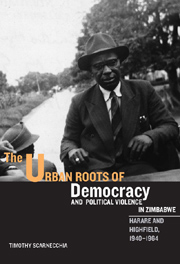Book contents
- Frontmatter
- Contents
- List of Illustrations
- Acknowledgments
- List of Abbreviations
- Notes to the Reader
- Introduction
- 1 Charles Mzingeli's Leadership and Imperial Working-Class Citizenship
- 2 Township Protest Politics
- 3 Resistance to the Urban Areas Act and Women's Political Influence
- 4 Changing Tactics: Youth League Politics and the End of Accommodation
- 5 The Early Sixties: Violent Protests and “Sellout” Politics
- 6 The “Imperialist Stooge” and New Levels of “Sellout” Political Violence
- 7 The ZAPU-ZANU Split and the Battlegrounds of Harare and Highfield
- Conclusion
- Notes
- Selected Bibliography
- Index
- Title in the series
3 - Resistance to the Urban Areas Act and Women's Political Influence
Published online by Cambridge University Press: 12 September 2012
- Frontmatter
- Contents
- List of Illustrations
- Acknowledgments
- List of Abbreviations
- Notes to the Reader
- Introduction
- 1 Charles Mzingeli's Leadership and Imperial Working-Class Citizenship
- 2 Township Protest Politics
- 3 Resistance to the Urban Areas Act and Women's Political Influence
- 4 Changing Tactics: Youth League Politics and the End of Accommodation
- 5 The Early Sixties: Violent Protests and “Sellout” Politics
- 6 The “Imperialist Stooge” and New Levels of “Sellout” Political Violence
- 7 The ZAPU-ZANU Split and the Battlegrounds of Harare and Highfield
- Conclusion
- Notes
- Selected Bibliography
- Index
- Title in the series
Summary
This chapter explores the role of Mzingeli's RICU in challenging the state's use of segregation legislation to reshape urban life for African residents. The potential impact of the N(UA)ARA in 1946 could have been dramatic given the ambitious goals contained within this legislation. It sought to engineer and plan urban residential segregation in ways that would maximize the availability of low-wage labor to urban-based industrialists while minimizing the continued growth of African residential areas in the “whites-only” suburbs and neighborhoods of the city. The costs were high for this plan to succeed, however, from the standpoint of the European bureaucracy that designed and implemented it. No contingency plans were made for African political opposition to the implementation phase, nor were the levels of passive and everyday resistance to the letter of the law by African residents as well as non-African landlords and employers realistically assessed. Six years after its inception, European bureaucrats were coming to realize the failure of the N(UA)ARA to regulate urban life, but from its beginning in 1946, the challenges to the status quo of township life were numerous.
Municipal administrators also tended to accept the N(UA)ARA as a necessary step to gain control over an increasingly “uncontrolled” African urban population. The director of Native Administration for the city, George Ballenden, recommended enthusiastically to the city council that it accept the provisions of the act because it would enable the city to salvage its Native Affairs finances through employer subsidies of rents while retaining control of “all housing of natives within its area” and increasing control over “the entry into, or the continued presence in, its area, of undesirable natives.”
- Type
- Chapter
- Information
- The Urban Roots of Democracy and Political Violence in ZimbabweHarare and Highfield, 1940–1964, pp. 49 - 68Publisher: Boydell & BrewerPrint publication year: 2008



